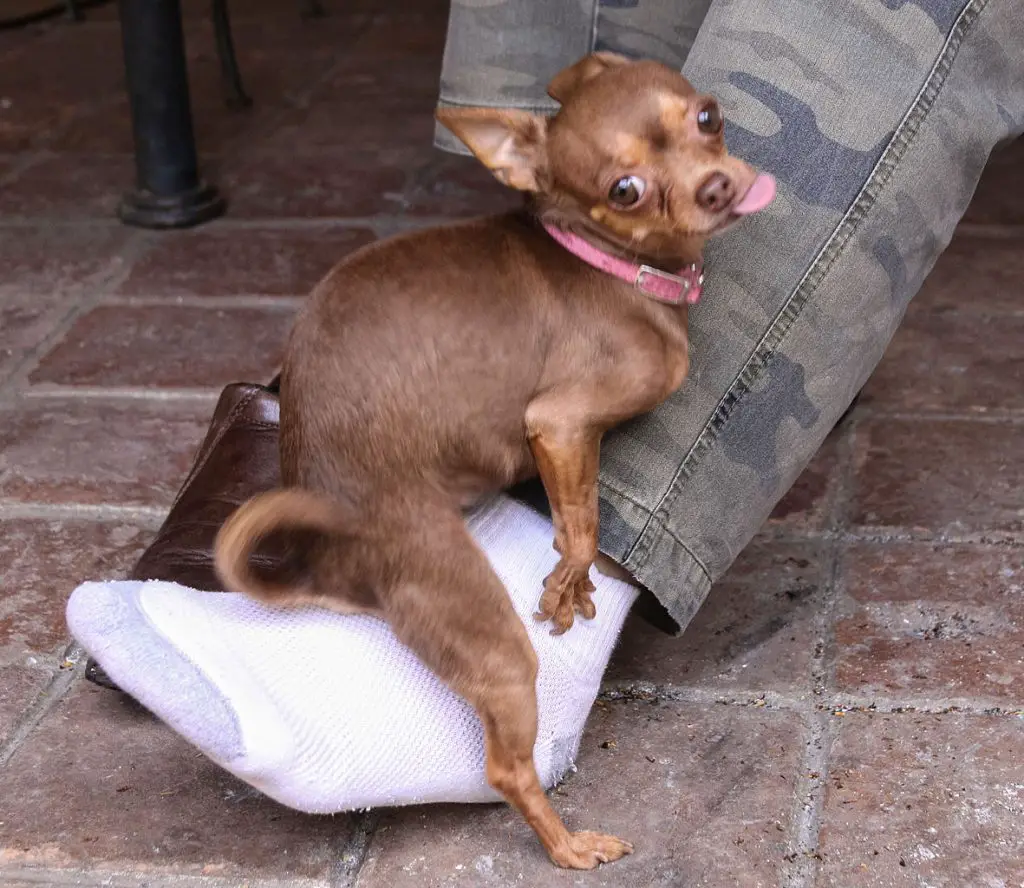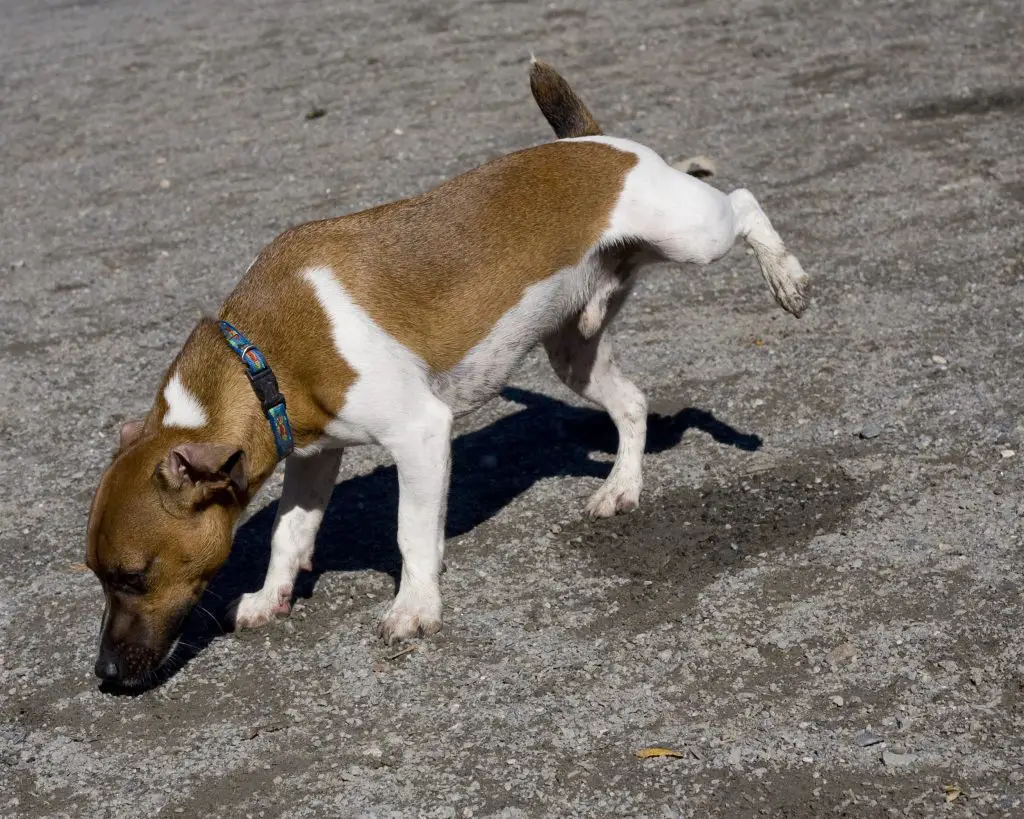Do you have a dog that likes to hump things? If so, you may have noticed that he sometimes bleeds afterward. This sometimes can be a bit alarming because no one likes to see their pet bleed. So, why do dogs bleed after they hump?
In this blog post, we will discuss the five most common reasons why dogs bleed when they hump. We will also provide tips for how to prevent your dog from bleeding in the future. Keep reading for more information!
- Key Takeaway
- 5 Reasons Why a Dog Bleeds When He Humps
- Why Would a Male Dog Leak Blood?
- How To Prevent My Dog From Humping
- What Happens If Dogs Hump Too Much?
- FAQs
- Q: What are the common causes of bleeding when a dog humps?
- Q: Is bleeding during humping normal for dogs?
- Q: Can neutering prevent bleeding when a dog humps?
- Q: Are there any home remedies to stop bleeding during humping?
- Q: Can bleeding during humping be a sign of a sexually transmitted infection?
- Q: Should I be concerned if my female dog bleeds during humping?
- Q: Can excessive humping lead to bleeding in dogs?
- Q: What should I do if my dog is bleeding when he humps?
- Conclusion and final thoughts
A dog might bleed when he humps due to reasons such as an infection in the reproductive organs, a urinary tract infection, the presence of bladder stones, prostate problems, or injuries to the genital area.
5 Reasons Why a Dog Bleeds When He Humps

Some dogs like to hump everything. It can be either funny or annoying. There isn’t a third option. However, sometimes some dogs start to bleed when they hump.
If your dog does this, here are 5 reasons why a dog bleeds when he humps:
1. Hormones

Prolactin is a hormone that is secreted by the pituitary gland. It plays an important role in reproduction and lactation. In males, prolactin is involved in the production of testosterone and the development of secondary sex characteristics.
High levels of prolactin can lead to infertility, impotence, bleeding from the penis, and decreased libido. Prolactin levels are regulated by the hypothalamus.
The hormone that can cause a dog to bleed when he humps is called prolactin. When a male dog’s prolactin levels are high, it can cause him to bleed from his penis. This is not a medical emergency and will resolve on its own.
If you’re concerned that your dog’s prolactin levels might be too high, talk to your veterinarian. They can perform a blood test to check hormone levels and make sure everything is normal. If prolactin levels are indeed elevated, there are medication options available to help bring them back down to normal.
Male dogs usually only bleed after they mate due to hormones present in their system. Prolactin is one of those hormones and it’s present in both male and female dogs.
Its main purpose is to help with milk production in nursing mothers, but it also has a small part in the mating process for both sexes. After a male dog mate, prolactin levels will rise and cause him to bleed from his penis.
2. Infection

Male dogs can bleed after humping due to infection. This is because the act of mating can introduce bacteria into the dog’s body, which can lead to an infection. The most common infection that leads to bleeding from the male reproductive organs in dogs is called prostatitis.
This is an inflammation of the prostate gland and can be caused by a number of different things, including bacteria, viruses, or even cancer. While it can be treated with antibiotics, it often recurs and can be quite dangerous if left untreated.
Prostatitis is a condition that can affect male dogs of any age, though it is most common in older dogs. The prostate gland is located just below the bladder and surrounds the urethra (the tube through which urine passes from the bladder to the outside). The prostate produces some of the fluid that makes up semen.
Prostatitis occurs when the prostate becomes inflamed, enlarged, or both. This can happen for a number of reasons, including infection (bacterial prostatitis), enlargement due to benign prostatic hyperplasia (BPH), or cancer.
While many cases of prostatitis are mild and require no treatment, more severe cases can be very painful and may lead to serious health problems.
3. Cancer

It’s important to understand a little bit about male reproductive anatomy. The testicles are where sperm is produced and stored.
They are suspended in the scrotum, which is a sac of skin that hangs down from the body just behind the penis.
The epididymis is a long, coiled tube that resides next to each testicle and serves as a storage site for sperm until they mature.
From there, they travel through the vas deferens (also known as the ductus deferens), two tubes that connect the epididymis to the urethra.
The urethra is a single tube that runs through the center of the penis and carries urine out of the body.
Cancer can cause bleeding from the reproductive organs in male dogs. This is most likely to occur with testicular cancer, but it can also occur with prostate cancer.
The bleeding may be mild or severe, and it may happen suddenly or over time. If your dog is bleeding from his reproductive organs, it’s important to see a vet right away.
Treatment will depend on the type and stage of the cancer, but it may include surgery, radiation therapy, or chemotherapy. With treatment, many dogs do well and go on to live long happy lives.
4. Testicular torsion
Testicular torsion is a condition that occurs when the spermatic cord, which provides blood flow to the testicle, becomes twisted.
This can happen in male dogs of any age but is most common in puppies between the ages of four and eight months old. If not treated immediately, testicular torsion can lead to the death of the affected testicle.
Symptoms of testicular torsion include sudden onset of severe pain in one or both testicles, swelling of the scrotum, and bleeding. If you notice any of these signs, it’s important to bring your dog to the vet right away for treatment.
Treatment for a testicular torsion typically requires surgery to untwist the spermatic cord and save the affected testicle. If both testicles are affected, one may need to be removed. With prompt treatment, most dogs make a full recovery and can return to their normal activities.
5. Injury
One of the main reasons why a dog bleeds when he humps is because of physical injury. Humping can put a strain on the genitals, as well as other areas of a dog’s body such as its legs back.
This excessive strain can lead to bruises, pulled muscles, and even cuts or lacerations that cause bleeding.
It’s also possible for the humping activity itself to cause enough irritation to break open small blood vessels in the skin which will result in some bleeding.
If your dog has been humping excessively it’s important to check them for any signs of serious injury or infection so they can be treated promptly.
Why Would a Male Dog Leak Blood?

There are several potential causes of blood in a dog’s urine. Some of them are an emergency while others are not something to worry about.
Here are the three most common reasons why male dog leaks blood:
1. Urinary tract infection
Urinary tract infection (UTI) is a common bacterial infection that can affect the bladder, kidneys, and urethra of male dogs.
Symptoms of UTI in male dogs may include bloody or cloudy urine, increased frequency of urination, straining to urinate, or discomfort during urination.
If left untreated, UTI can lead to serious health complications such as kidney damage or failure. Early diagnosis and treatment of UTIs are essential for the best possible outcome.
Your veterinarian will likely recommend a course of antibiotics to clear the infection and may also recommend additional treatments such as dietary changes or urinary tract supplements.
Prevention of UTI through good hygiene practices and prompt treatment of any underlying health conditions is also important in protecting your dog’s health.
2. Inflammation of the tissue around the urethra
The tissue around the urethra in male dogs is called the prepuce. The prepuce is a thin layer of skin that covers the tip of the penis. It is also known as the foreskin.
The prepuce protects the dog’s penis from injury and infection. It also keeps the penis clean and free from debris.
This is a condition that can occur in male dogs when the tissue around the urethra becomes inflamed. This can happen for a number of reasons, including infection, injury, or allergies.
Symptoms of this condition include difficulty urinating, blood in the urine, and pain during urination. Treatment will vary depending on the underlying cause but may include antibiotics or anti-inflammatory medications.
3. Kidney stones
Kidney stones in male dogs are a common condition that can be caused by a variety of things. Stones can form when there is too much of a certain substance in the urine, or when the urine is too acidic. They can also form if the dog doesn’t drink enough water or if he has an infection.
Symptoms of kidney stones in male dogs include pain during urination, blood in the urine, and difficulty urinating. If you think your dog may have kidney stones, take him to the vet for an examination.
Treatment depends on the size and type of stone but may involve surgery or medication. Prevention is key, so make sure your dog drinks plenty of water.
4. Prostate tumor
Tumors are abnormal growths of cells in the body. They can be benign, which means they are not cancerous, or malignant, which means they are cancerous.
Male dogs can get both types of tumors. Benign tumors are not usually a problem and don’t need to be removed. Malignant tumors can spread to other parts of the body and are a serious health concern.
There are several types of tumors that can cause male dogs to leak blood, but the most common is the prostate tumor.
Prostate tumors are usually benign, but they can grow and press on the urethra, causing blood to leak. Other less common causes of bloody urine in male dogs include bladder or kidney tumors, infection, and trauma.
If your dog is leaking blood from his penis, it’s important to have him seen by a veterinarian as soon as possible to determine the cause and start treatment.
Treatment will vary depending on the underlying cause but may include surgery, radiation therapy, or chemotherapy. With prompt treatment, many dogs with bloody urine can go on to live happy and healthy lives.
You may also like
How To Prevent My Dog From Humping
To prevent your dog from humping, you can employ various strategies such as training commands, redirection of energy, neutering, ensuring they get enough exercise, and seeking professional help if necessary.
Training Commands
Training your dog to understand basic commands like “stop” or “no” can be very effective in preventing unwanted humping. Consistency is key here; each time your dog starts to hump, use the command and reward them when they obey.
Redirection of Energy
When you notice your dog starting to hump, try to redirect their energy towards a more appropriate activity. This could be playing with a toy, going for a walk, or doing some obedience training. The idea is to distract them before the behavior escalates.
Neutering
Neutering your dog can significantly reduce their desire to hump. This procedure eliminates the hormones that drive this kind of behavior. It’s best to consult with your vet to understand the right age and time for neutering your pet.
Adequate Exercise
Ensure your dog gets plenty of physical exercise and mental stimulation. A tired dog is less likely to exhibit problem behavior. Regular walks, playtime, and puzzle toys can help keep your dog occupied and drain off excess energy that might otherwise be directed toward humping.
Professional Help
If your dog’s humping behavior becomes excessive or problematic despite your best efforts, it may be time to seek professional help. A certified dog trainer or behaviorist can provide personalized strategies and techniques to manage and reduce your dog’s humping behavior says Preventive Vet.
What Happens If Dogs Hump Too Much?
If dogs hump too much, it could be a sign of an underlying medical condition. Humping is often seen as a dominant behavior, but it can also be a way for dogs to relieve stress or anxiety.
If your dog is humping excessively, you should talk to your veterinarian about possible causes and treatment options.
Excessive humping can also be frustrating for owners. If your dog is humping people or furniture, you may need to provide more structure and exercise in their life.
This could include additional walks, training sessions, or interactive toys and puzzles. With patience and positive reinforcement, most dogs can learn to control their humping behavior.
FAQs
Q: What are the common causes of bleeding when a dog humps?
A: Common causes include urinary tract infections, prostate problems, penile injuries, sexually transmitted infections, or tumors. It is best to have a veterinarian perform a thorough examination to identify the specific cause.
Q: Is bleeding during humping normal for dogs?
A: No, bleeding during humping is not normal and should be taken seriously. It may indicate an underlying health issue that requires medical attention.
Q: Can neutering prevent bleeding when a dog humps?
A: Neutering can help prevent certain medical conditions that may cause bleeding during humping, such as prostate problems or testicular tumors. However, it is not a guarantee and other causes should be ruled out by a veterinarian.
Q: Are there any home remedies to stop bleeding during humping?
A: It is not recommended to rely on home remedies for bleeding during humping. The underlying cause needs to be properly diagnosed and treated by a veterinarian to ensure the well-being of your dog.
Q: Can bleeding during humping be a sign of a sexually transmitted infection?
A: Yes, bleeding during humping can be a sign of a sexually transmitted infection in dogs. It is crucial to have your dog examined by a veterinarian to determine the appropriate treatment to prevent further complications.
Q: Should I be concerned if my female dog bleeds during humping?
A: Yes, if a female dog bleeds during humping, it could be a sign of an infection, injury, or hormonal imbalance. It is important to consult a veterinarian to determine the cause of the bleeding and to ensure the well-being of your pet.
Q: Can excessive humping lead to bleeding in dogs?
A: Excessive or rough humping can cause injuries to the genital area, leading to bleeding in dogs. It is advisable to discourage and manage excessive humping behavior to prevent such injuries from occurring.
Q: What should I do if my dog is bleeding when he humps?
A: If your dog is bleeding when he humps, it is recommended to contact a veterinarian immediately for guidance. The veterinarian will be able to assess the situation, provide appropriate treatment, and offer advice on preventing future episodes of bleeding.
Conclusion and final thoughts
In conclusion, there are five primary reasons why a dog may bleed when they hump: infection or injury; reproductive hormones; excitement; dominance and submission behaviors; and inappropriate humping behavior.
Though many of these causes may be harmless, it is important to keep an eye on your pet’s activities and seek veterinary care if bleeding persists or becomes more severe.

